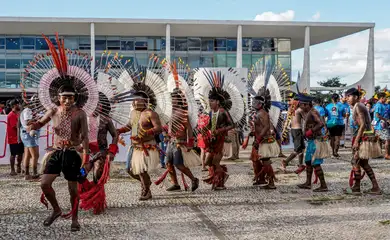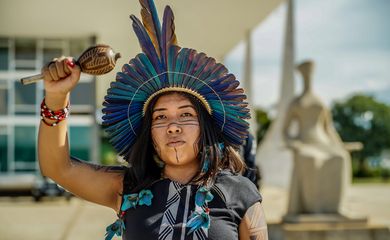Indigenous leaders from all 5 Brazilian regions voice climate concerns

Long periods of drought or heavy rainfall are taking indigenous leaders across all five Brazilian regions by surprise. Climate change is having an impact on production in the countryside and affecting the quality of life of entire communities, chiefs at the Terra Livre Camp in Brasília during Indigenous April say.

Interviewed by Agência Brasil, five chiefs from different parts of Brazil deplored the destruction and pollution of natural resources as well as the pressure from non-indigenous people against their preserved sites.
The Southeast
Chief Baiara Pataxó, 64, who lives in a community in the town of Açucena, Minas Gerais, says that the manioc, corn, and bean plantations have stopped yielding as much as they used to over the last decade. The produce is sold to traders in nearby areas and provides a livelihood for a community formed by 80 people.
“In the past, the rains started in September; in recent years, not until December. This is clearly not normal,” he stated.
In addition to climate change, the community in Minas Gerais was impacted by the environmental crime of January 25, 2019, when the dam of the Córrego do Feijão Mine, owned by mining company Vale, in Brumadinho, collapsed. In addition to killing 272 people, the tailings polluted the region’s Doce and Corrente rivers. “All of this has been terrible. We’re currently working on replanting 45 thousand native and fruit tree seedlings. Twenty indigenous people are working on this,” he noted.
The North
The connection between climate change and other criminal actions is also witnessed by 39-year-old Yanomami Chief Dario Kopenawa, who lives in Roraima state.
“We’ve been witnessing the invasion of miners and prospectors where we live. We’re a community of 32 thousand people suffering from climate change and mercury contamination simultaneously,” he said.
The rains have become “considerably different” from what they were during his adolescence and childhood in the region, he added.
“We’ve been asking our shamans for our rains. But it’s a fact that the taioba, manioc, and banana fields aren’t what they used to be.”
The Northeast
Chief Tchydjo Ue, 76, of the Fulni-ô people, lives in a village in Pacatuba, Sergipe, home to 86 families. He believes the landscape today has completely changed compared to the days of his youth.
“We’re close to the coast [96 km], but it’s much hotter than before. The younger people are finding it difficult to work in the fields and giving up,” said the leader, who argued that the changes in climate have combined with changes in behavior: “The young people have also changed. They want to leave. They’re always online on their cell phones,” he remarked.
In order to diversify activities, the indigenous chief said he has been encouraging arts and crafts, since corn, manioc, and beans have proved to be insufficient for subsistence. Another aspect he values is learning about nature. “I’ve been asked to speak in Europe and the United States about indigenous knowledge, but people here are in more urgent need to know more about us.”
The Central-West
The destruction of the cerrado biome and climate change have been closely watched by Chief Tanoné. She is 70 years old and has lived in the Federal District since 1986. She remembers with regret that Brasília used to have cold seasons, which “disappeared.”
The community where she lives, in the Noroeste district, is home to 16 families. In the area, which has grown as a result of real estate expansion, she says she has been working to restore the landscape. Its 16 hectares were once covered in corn, beans, and cotton.
“Beans have become rare, and the same is true for cotton. It's either a lack of rain or intense storms.” She urged government officials to plant the traditional ipê trees so the place could gain fresh colors.
The South
In the town of José Boiteux, in Santa Catarina, a community of 2,300 people from the Xokleng ethnic group is worried about the approaching rainy season, which has become more intense in the last decade.
Chief Setembrino, 53, argued that the main task at hand is to keep an eye on the floods and teach environmental conservation to indigenous people in the classroom.
“It's right thing to do to pay attention to the Amazon, but we also need to remember the South. We're now working on planting pine trees. We have to look at the present as well as the future.”
Geomar Crendô, also a Xokleng leader, pointed out that the changes in the rainfall regime have brought the community's security under threat. “Since it's been raining a lot more, the containment dam often reaches its limit. We no longer have a safe place to live,” he declared.




